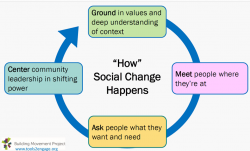Feb
18
2019
In the late 90s and early 2000s, one of the Building Movement Project’s founding members, Linda Campbell, was working with service providers struggling with shrinking budgets and increased need in her own hometown of Detroit. Linda watched as public funding for services to people living in poverty was cut. At the same time, the City was referring hungry residents to the area’s largest soup kitchen which had no government funds. Grandparents were coming with their grandchildren and it became clear that feeding the hungry was necessary, but it was not stopping the cycle of poverty Detroiters were experiencing, especially as cuts for services became more and more rampant. This was the catalyst for Social Service and Social Change: A Process Guide, in which Linda and the BMP staff outlined practical ways social service organizations could continue to provide much-needed services, while also doing more, including engaging constituents in addressing root causes.
More than two decades after Linda developed BMP’s framework for thinking about integrating service and social change, it’s an area of work we’re still deeply committed to. To continue our exploration, we’ve recently been talking with long-time partners Reverend Roslyn Bouier, Managing Director of the Brightmoor Connection Food Pantry, and Kea Mathis, Family Engagement Organizer with the Detroit People’s Platform, about how they work together to connect the dots between food insecurity and public policies that undermine families and put them further at risk, while building community leadership to shift power. In particular, we wanted to dig deeper into “how” real social change happens. Not just the process, but the approach. What makes the work Reverend Roslyn and Kea are doing in Detroit different from other social change efforts, and why does it matter? Our discussions about their approach were distilled down into the following four components:
- Ground in values and deep understanding of context
- Meet people where they’re at
- Ask people what they want and need
- Center community leadership in shifting power
Though these may seem like simple ideas, they require and catalyze narrative and power shifts that get to the root of oppressive structures. Positioning people as their own best advocates lays the foundation for a sustainable, values-driven movement for liberation, grounded and led by those most deeply impacted by injustice. Join me on Feb 26th at 4 pm EST to hear more from Kea and Reverend Roslyn about how they integrate these four approaches into every aspect of their work and how any organization can do the same.

